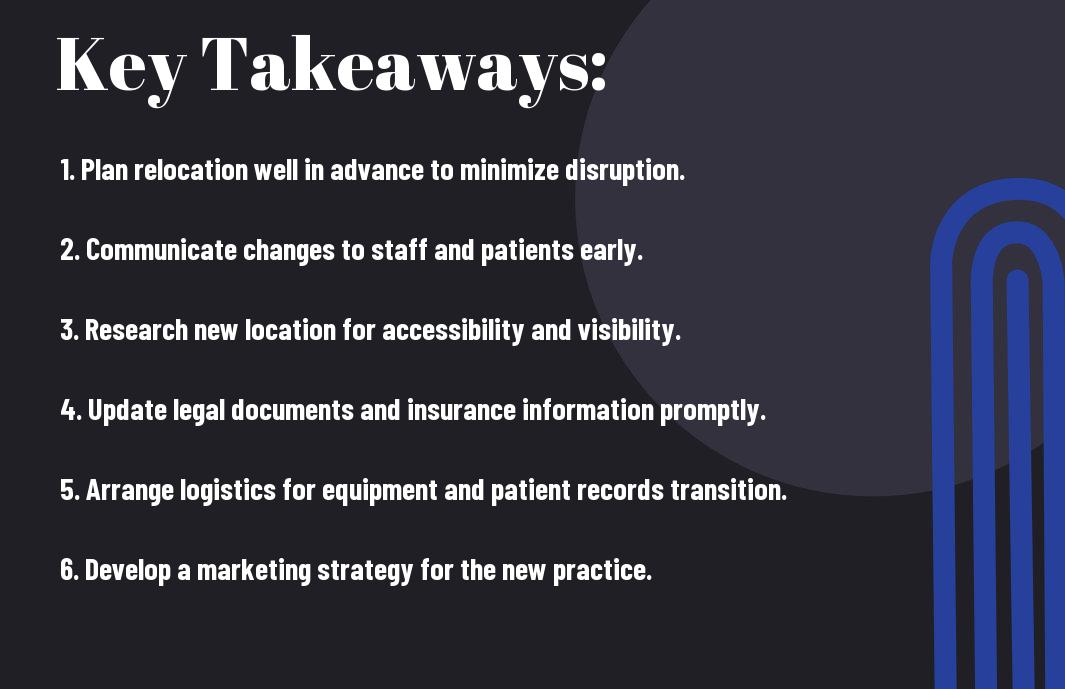It’s important to approach medical practice relocation with a strategic mindset to ensure a seamless transition. Whether you’re moving to a new location to accommodate growth or to better serve your patients, understanding the key steps involved will significantly reduce stress. From planning your logistics to communicating with staff and patients, a comprehensive roadmap can help guide you through the process. In this post, you’ll discover critical steps that will empower you to navigate this significant change with confidence and ease.


Assessing Reasons for Relocation
As you contemplate moving your medical practice, it is imperative to evaluate your motivations thoroughly. Understanding the underlying reasons for the relocation can significantly influence the success of your transition. Consider factors such as patient demographics, competition, facility requirements, and overall growth potential in the new area. Addressing these aspects upfront will help you make informed decisions and create a solid plan for your practice’s future.
Evaluating Current Location
Reasons for assessing your current location include its impact on patient accessibility and staff satisfaction. Examine aspects like foot traffic, parking availability, and proximity to other medical services. A thorough evaluation enables you to pinpoint the strengths and weaknesses of your existing location, helping you determine if a move is warranted.
Identifying Ideal New Location
Relocation involves identifying a new site that aligns with your practice goals and patient needs. Research demographic trends, local healthcare infrastructure, and potential competition to ensure that your new location can support sustained growth. Additionally, consider factors such as visibility, accessibility, and compliance with regulations as you evaluate potential sites.
It is vital to analyze community characteristics when pinpointing your ideal new location. Investigate the local population’s age, income levels, and healthcare needs to match your specialty with the area’s demand. Visiting potential neighborhoods and speaking with local professionals can provide insights into clinical needs and competition. This groundwork facilitates an informed decision, optimizing the chances for your practice’s success in its new environment.
Planning the Transition
Clearly, planning your practice relocation involves strategic foresight and careful consideration. You must assess your current operation, identify potential challenges, and set objectives to ensure a seamless transition. Engaging your team in the planning process can help you gather valuable insights while fostering a supportive environment. This phase deserves thorough attention to pave the way for a successful move and mitigate disruptions to your practice.
Creating a Relocation Timeline
An effective relocation timeline is imperative for your practice’s success. It helps you set deadlines, allocate resources, and coordinate activities efficiently. Break down your transition into phases, allowing for flexibility as you address unexpected hurdles. By establishing clear milestones, you can ensure that everything from notifying patients to setting up the new space is executed systematically.
Budgeting for Expenses
Expenses are a significant aspect of your practice relocation that you should account for early in the process. Budgeting effectively will help you minimize unexpected costs that could disrupt your plans and financial stability. Consider all potential expenses, including rent, utilities, renovation, and moving services, to establish a realistic budget that supports your transition.
For instance, beyond the immediate costs of moving and leasing a new space, you should factor in potential expenses such as upgrades to medical equipment, marketing your new location to patients, and any permits or legal fees associated with the relocation. Operating with a detailed budget not only keeps your financial health in check but also ensures you can allocate sufficient resources for a smooth transition and continued patient care. Evaluating your expenses comprehensively will empower you to make informed decisions throughout the relocation journey.
Legal and Regulatory Considerations
After deciding to relocate your medical practice, it’s vital to understand the legal and regulatory considerations involved. This includes navigating state and federal laws, ensuring that your new location complies with zoning regulations, and addressing any changes in healthcare regulations that may impact your operations. Consulting with legal professionals who specialize in healthcare can provide valuable guidance to ensure your transition adheres to all necessary laws and standards.
Licensure and Credentialing
On relocating, you must verify that all necessary licenses and credentials are current and accepted in your new jurisdiction. Each state may have different requirements for professional licensure, so it is vital to reach out to the relevant licensing boards. Additionally, updating any staff credentials ensures that your practice maintains operational compliance and upholds patient safety standards during the transition.
Compliance with Local Laws
Regulatory compliance with local laws is a fundamental aspect of your practice’s new location. It’s vital to familiarize yourself with any specific health codes, employment laws, and building regulations that differ from your previous practice. This may involve reviewing your lease agreement, understanding local taxation policies, and ensuring adherence to emergency preparedness regulations that may be unique to your new area.
Plus, compliance goes beyond just legal statutes; it includes engaging with local health departments to ensure you meet any public health requirements, as well as updating your practice policies to align with new community standards. These proactive measures will help you establish a strong foundation in your new location, promoting a sense of trust and reliability within the community.
Communication Strategies
Your approach to communication during a medical practice relocation will significantly affect how smoothly the transition goes. Effective communication should encompass all stakeholders, including patients, staff, and the wider community, to ensure everyone is informed and engaged throughout the process.
Informing Patients and Staff
To keep your patients and staff informed about the relocation, initiate a communication plan well in advance. Use multiple channels, such as emails, newsletters, and in-office posters, to provide updates on the move, new location details, and any changes that may affect their experience.
Public Relations and Marketing
Among your duties during a relocation is the need to develop a robust public relations and marketing strategy. This will help you maintain your practice’s reputation while attracting new patients to the new location.
Understanding the role of public relations and marketing during a relocation is vital for sustaining patient trust and interest. You should consider crafting press releases, hosting community events, and leveraging social media platforms to announce the move. Engaging graphic design can enhance visibility and the marketing message. Recall, the goal is not just to inform current patients but to invite the community to learn about and engage with your practice in its new setting.
Logistics of the Move
Unlike your typical residential move, relocating a medical practice involves meticulous planning and coordination of specialized resources. You’ll need to consider the physical transportation of medical equipment, patient records, and possibly even pharmaceuticals. Ensuring that everything is securely packed, transported, and set up allows your practice to resume normal operations quickly and effectively, minimizing disruption to patient care.
Hiring Professional Movers
About enlisting the help of professional movers who specialize in medical practice relocations. They understand the intricacies of handling sensitive medical equipment, ensure compliance with regulations, and can coordinate the logistics of moving both large and fragile items. This expertise can save you time, reduce stress, and provide peace of mind during the transition.
Setting Up the New Practice
Between the excitement of a new location and the pressure of a seamless transition, setting up your new practice is imperative to your success. You will need to establish a functional environment that accommodates your medical equipment, staff, and patient flow while ensuring compliance with healthcare regulations.
Understanding the layout of your new space is key to creating an efficient workflow. You’ll want to design areas for patient reception, examination, and treatment so that they facilitate a smooth transition for both staff and patients. Additionally, consider technology installations, such as electronic health record systems, to ensure that all processes are integrated and operational from day one. This strategic approach not only supports effective patient care but also enhances the overall patient experience in your new facility.
Post-Move Evaluation
Once again, a thorough post-move evaluation is vital in ensuring the long-term success of your new medical practice location. Assessing your relocation outcomes allows you to identify areas for improvement and adjust strategies moving forward. By gathering insights from both patients and staff, you can fine-tune operations, reinforce patient satisfaction, and cultivate a conducive environment that aligns with your practice goals.
Gathering Feedback from Patients
One effective way to gauge the success of your relocation is by soliciting feedback from your patients. Engage them through surveys or informal conversations to understand their experiences regarding access, comfort, and overall satisfaction with your new location. This valuable input not only helps you address any immediate concerns but also fosters stronger relationships, demonstrating that you value their opinions and are committed to their care.
Adjusting Operations as Needed
One of the most important aspects of post-move evaluation is identifying operational adjustments to enhance efficiency and service quality. This could involve streamlining appointment scheduling, adapting office layouts for better workflow, or expanding staff roles to meet patient demand. By analyzing daily functions and being open to change, you position your practice for growth and sustainability.
Post-move, you may discover that certain operational aspects need fine-tuning to better serve your patients. This could involve revisiting workflow processes, optimizing staff assignments, or integrating new technologies to improve efficiency. Keeping lines of communication open with your team will help you pinpoint specific challenges and collaboratively develop solutions. By remaining adaptable and responsive, you ensure a seamless transition that enhances patient care and enhances your practice’s performance.
Final Words
Presently, as you navigate the complexities of relocating your medical practice, it’s crucial to follow a structured approach. By planning meticulously, communicating with your team, and ensuring compliance with legal requirements, you can facilitate a seamless transition to your new location. Evaluate your patient base and market environment, engage professional services where needed, and keep your patients informed throughout the process. With careful attention to detail and a proactive attitude, you can ensure that your move enhances your practice’s efficiency and patient care.




